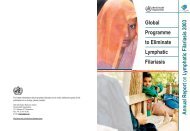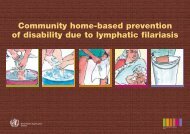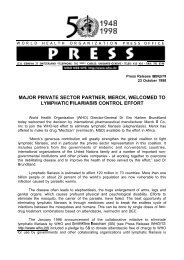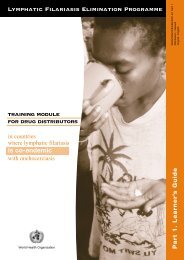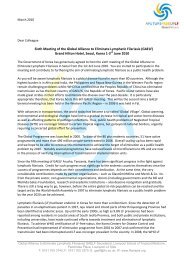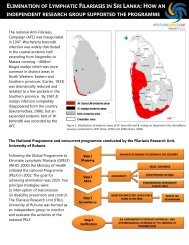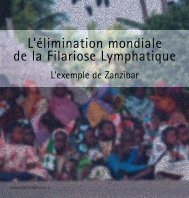English - Global Alliance to Eliminate Lymphatic Filariasis
English - Global Alliance to Eliminate Lymphatic Filariasis
English - Global Alliance to Eliminate Lymphatic Filariasis
You also want an ePaper? Increase the reach of your titles
YUMPU automatically turns print PDFs into web optimized ePapers that Google loves.
REPORT OF THE 6 TH GAELF MEETING, JUNE 2010<br />
Mr Jose de la Cruz noted three types of unfamiliarity that create barriers <strong>to</strong> integrated<br />
management of lower limb conditions. First, there is lack of familiarity with the clinical and<br />
social <strong>to</strong>ols <strong>to</strong> address these problems, for which guidelines are necessary. Second, there is<br />
a lack of knowledge about the epidemiology of various lower limb conditions in most areas.<br />
Third, there is a lack of familiarity with other organizations that are already addressing some<br />
of these conditions (e.g., NGDOs working in leprosy) that can be integrated with LF<br />
morbidity management. He suggested that NGDOs that are working in the field can provide<br />
WHO with a map that indicates they are active, what they are doing, and with whom they<br />
are partnering. This could be useful <strong>to</strong> WHO and <strong>to</strong> programme managers in developing a<br />
coordinated approach.<br />
Dr Leda Hernandez asked about the specific role of the LF programme manager in morbidity<br />
management, and considerable discussion focused on this. Dr Lisy Rasoazanamiarana<br />
reported that, in Madagascar, the role of the government has been <strong>to</strong> coordinate with<br />
NGDOs <strong>to</strong> set up the programme, provide training in morbidity management for health<br />
workers, and establish standards for patient follow-up. The NGDOs serve as an interface<br />
between the government and the community; their covenant with the community enables<br />
them <strong>to</strong> motivate community support for the programme and ensure adequate patient<br />
follow-up. Patients with ADL episodes are managed within the public health system. The<br />
Ministry of Health provides training on managing a variety of conditions of the lower limb,<br />
including diabetes and LF.<br />
Dr Pepe agreed, and said that integration does not necessarily require combining the<br />
services of several NGDOs, all with separate disease mandates. Rather, a single interested<br />
NGDO with expertise in one area can, if motivated, help <strong>to</strong> address a variety of issues and<br />
diseases. Especially in low-income countries, flexibility is important.<br />
Dr Brantus summarized the session by thanking the participants. He noted that the<br />
publication of WHO treatment guidelines will represent an important step forward. He<br />
called for developing clear strategies among interested parties, focused on integration<br />
based in partnership. He also acknowledged that NGDOs and Ministries of Health have<br />
different roles within a partnership, and clarity around these roles will facilitate explicit and<br />
specific action on the part of each partner. Integration of lower limb care is just one<br />
expression of the impulse <strong>to</strong>ward greater integration of the health and medical systems<br />
now underway in many countries.<br />
51



